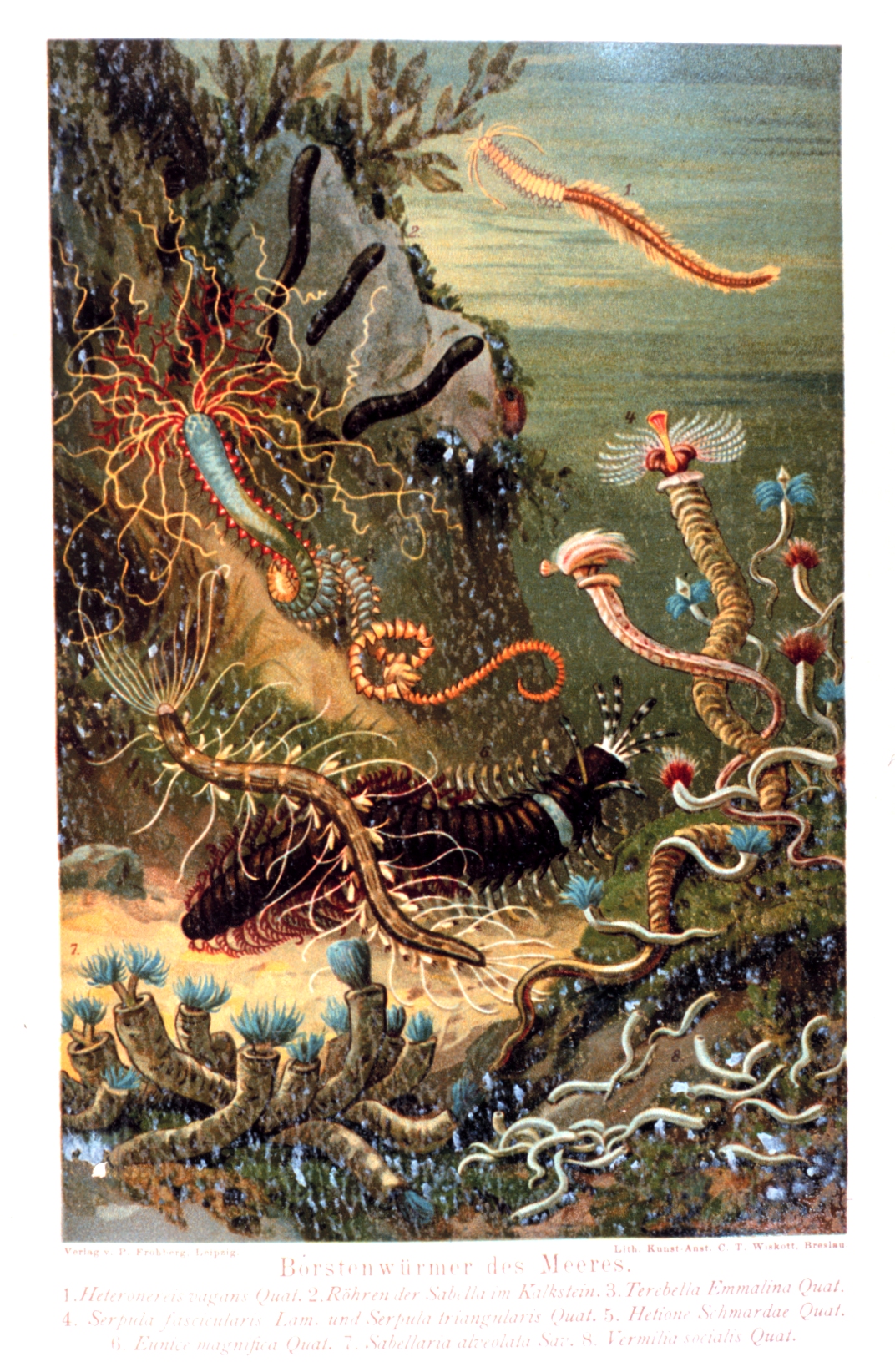- Polychaete
Taxobox
fossil_range =Cambrian (or earlier?) - present
name = Polychaetes

image_width = 250px
image_caption = "A variety of marine worms": plate from "Das Meer" by M. J. Schleiden (1804–1881).
regnum =Animal ia
phylum =Annelida
classis = Polychaeta
classis_authority = Grube, 1850
subdivision_ranks = Subclasses
subdivision =Palpata
Scolecida The Polychaeta or polychaetes are a class of
annelid worms, generally marine. Each body segment has a pair of fleshy protrusions calledparapodia that bear many bristles, calledchaeta e, which are made ofchitin . Indeed the polychaetes are sometimes referred to as bristle worms. More than 10,000 species are described in this class. Common representatives include thelugworm ("Arenicola marina") and thesandworm orclam worm "Nereis".Anatomy and physiology
The polychaetes' paddle-like and highly vascularized parapodia are used for movement and act as the
annelid 's primary respiratory surfaces (parapodia can be thought of as kinds of externalgill s that are also used for locomotion). Polychaeta also have well-developed heads compared to other annelids.Ecology
s.
A few groups have evolved to live in terrestrial environments, like Namanereidinae with many terrestrial species, but are restricted to humid areas. Some have even evolved cutaneous invaginations for aerial gas exchange.
One notable polychaete, the
Pompeii worm ("Alvinella pompejana") is endemic to thehydrothermal vent s of thePacific Ocean . Pompeii worms are thought to be the most heat-tolerant complex animals known.A recently discovered genus "
Osedax " includes the Bone-eating snot flower.Another remarkable polychaete is "
Hesiocaeca methanicola ", which lives onmethane clathrate deposits."
Lamellibrachia luymesi" is acold seep tube worm that reaches lengths of over 3 meters and may be the most long lived animal at over 250 years old.Evolutionary history
The oldest crown group polychaetes fossils come from the
Sirius Passet Lagerstatte , which is tentatively dated to the lower-middleAtdabanian (early Cambrian). [Conway Morris, S. and Peel, J.S. 2008. The earliest annelids: Lower Cambrian polychaetes from the Sirius PassetLagerstätte, Peary Land, North Greenland. Acta Palaeontologica Polonica 53 (1): 137–148.] Many of the more famousBurgess Shale organisms, such as "Canadia" and "Wiwaxia ", may also have polychate affinites. An even older fossil, "Cloudina ", dates to the terminalEdiacaran period; this has been interpreted as an early polychaete, although consensus is absent.citation
author = Miller, A.J.
year = 2004
title = A Revised Morphology of Cloudina with Ecological and Phylogenetic Implications
url = http://ajm.pioneeringprojects.org/files/CloudinaPaper_Final.pdf
accessdate = 2007-04-24 ]Being soft bodied, the fossil record of polychaetes is dominated by their fossilized jaws, known as
scolecodonts , and themineral ized tubes that some of them secrete.Taxonomy and systematics
Taxonomically, the polychaetes are thought to be
paraphyletic , meaning that as a group it contains its most recent common ancestor, but does not contain all the descendants of that ancestor. Groups that may be descended from the polychaetes include theearthworm s, theleech es,sipuncula ns, andechiura ns. The Pogonophora andVestimentifera were once considered separate phyla, but are now classified in the polychaete familySiboglinidae .Much of the classification below matches Rouse & Fauchald, 1998, although that paper does not apply ranks above family.
Older classifications recognize many more (sub)orders than the layout presented here. As comparatively few polychaete
taxa have been subject tocladistic analysis, some groups which are usually considered invalid today may eventually be reinstated.*Subclass
Palpata
**OrderAciculata
***Basal or "incertae sedis "
****FamilyAberrantidae
****FamilyNerillidae
****FamilySpintheridae
***SuborderEunicida
****FamilyAmphinomidae
****FamilyDiurodrilidae
****FamilyDorvilleidae
****FamilyEunicidae
****FamilyEuphrosinidae
****FamilyHartmaniellidae
****FamilyHistriobdellidae
****FamilyLumbrineridae
****FamilyOenonidae
****FamilyOnuphidae
***SuborderPhyllodocida
****FamilyAcoetidae
****FamilyAlciopidae
****FamilyAphroditidae
****FamilyChrysopetalidae
****FamilyEulepethidae
****FamilyGlyceridae
****FamilyGoniadidae
****FamilyHesionidae
****FamilyIchthyotomidae
****FamilyIospilidae
****FamilyLacydoniidae
****FamilyLopadorhynchidae
****FamilyMyzostomatidae
****FamilyNautillienellidae
****FamilyNephtyidae
****FamilyNereididae
****FamilyParalacydoniidae
****FamilyPholoidae
****FamilyPhyllodocidae
****FamilyPilargidae
****FamilyPisionidae
****FamilyPolynoidae
****FamilyPontodoridae
****FamilySigalionidae
****FamilySphaeodoridae
****FamilySyllidae
****FamilyTyphloscolecidae
****FamilyTomopteridae
**OrderCanalipalpata
***Basal or "incertae sedis "
****FamilyPolygordiidae
****FamilyProtodrilidae
****FamilyProtodriloididae
****FamilySaccocirridae
***SuborderSabellida
****FamilyOweniidae
****FamilySiboglinidae (formerly the phyla Pogonophora & Vestimentifera)
****FamilySerpulidae
****FamilySabellidae
****FamilySabellariidae
****FamilySpirorbidae
***SuborderSpionida
****FamilyApistobranchidae
****FamilyChaetopteridae
****FamilyLongosomatidae
****FamilyMagelonidae
****FamilyPoecilochaetidae
****FamilySpionidae
****FamilyTrochochaetidae
****FamilyUncispionidae
***SuborderTerebellida
****FamilyAcrocirridae (sometimes placed in Spionida)
****FamilyAlvinellidae
****FamilyAmpharetidae
****FamilyCirratulidae (sometimes placed in Spionida)
****FamilyCtenodrilidae (sometimes own suborder Ctenodrilida)
****FamilyFauveliopsidae (sometimes own suborder Fauveliopsida)
****FamilyFlabelligeridae (sometimes suborder Flabelligerida)
****FamilyFlotidae (sometimes included in Flabelligeridae)
****FamilyPectinariidae
****FamilyPoeobiidae (sometimes own suborder Poeobiida or included in Flabelligerida)
****FamilySternaspidae (sometimes own suborder Sternaspida)
****FamilyTerebellidae
****FamilyTrichobranchidae
*SubclassScolecida
**FamilyAeolosomatidae
**FamilyArenicolidae
**FamilyCapitellidae
**FamilyCossunidae
**FamilyMaldanidae
**FamilyOphelidae
**FamilyOrbiniidae
**FamilyParaonidae
**FamilyParergodrilidae
**FamilyPotamodrilidae
**FamilyPsammodrilidae
**FamilyQuestidae
**FamilyScalibregmatidae ee also
*
Epitoky , a form of reproduction of "Polychaetae".References
* Campbell, Reece, and Mitchell. Biology. 1999.
* cite journal
author = Rouse, Greg W.; Fauchald, Kristian
year = 1998
title = Recent views on the status, delineation, and classification of the Annelida
journal = American Zoologist
volume = 38 | pages = 953–964
doi = 10.1093/icb/38.6.953External links
* Special issue dedicated to polychaete published in "Marine Ecology". [http://www.blackwell-synergy.com/toc/mae/26/3-4 Read the article abstracts online]
* [http://www.tafi.org.au/zooplankton/imagekey/annelida/index.html Marine Polychaete Larva - Guide to the Marine Zooplankton of south eastern Australia ]
Wikimedia Foundation. 2010.
